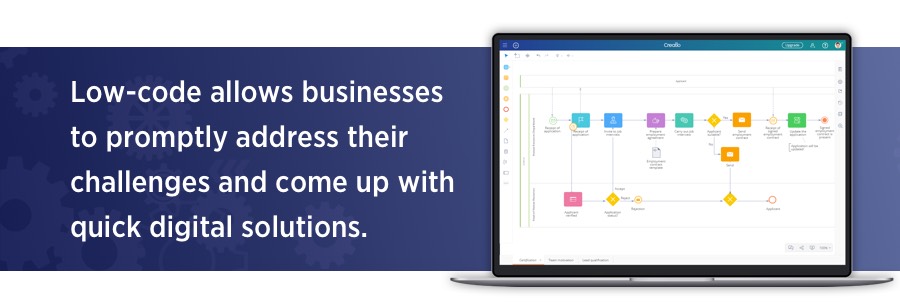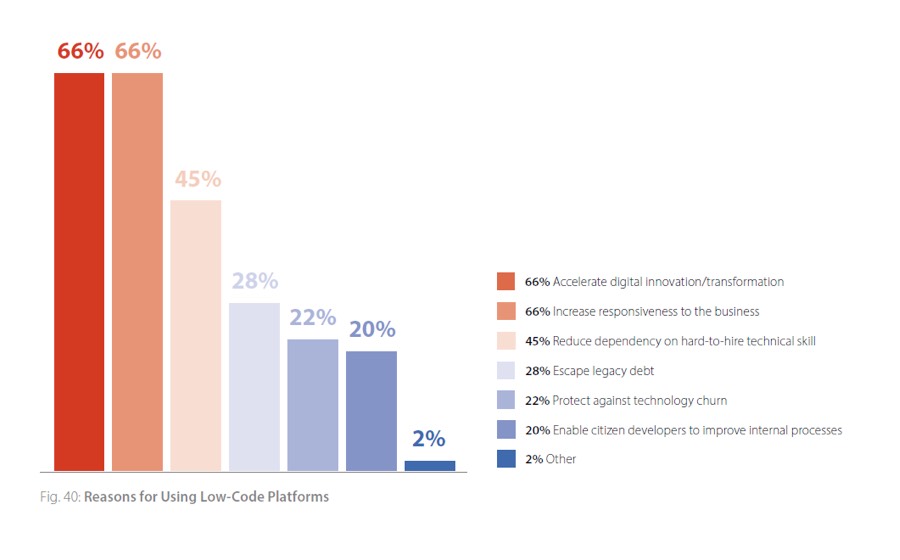Everyone knows the saying ‘slow and steady wins the race’. But can we really trust it nowadays when the world we live in is highly competitive? Not putting this entire fable concept to doubt, the answer to the question depends on what race we want to win. Adoption of a low-code development approach can advance your business promptly when it comes to a sprint and set the scene for a marathon.
Low-code development platforms are gaining increasing popularity as more companies choose them to build apps and transform their IT infrastructures.
Gaining Control of Customer Engagements
What if every customer could deal with your single most effective sales or service person?
By 2032, low-code development market is expected to reach $187 billion compared to $14 billion in 2022. That means the compound annual growth rate is predicted to be around 29.5% throughout the mentioned period.
So what makes these platforms low-hanging fruit that many companies want to pick? Let’s start with the basics.
- What is Low-Code
- Types of Low-Code Platforms
- Features of Low-Code Development
- Top 5 Benefits of Low-Code Development
- Reduced IT Costs
- Fast Software Delivery
- Improved Business Agility
- Greater Productivity
- Multiple Integrations and Legacy Systems Support
- Key Challenges that Low-Code Comprises
- Adoption of Low-Code Across Industries
- A Strategy to Follow
The Essence of Low-Code
Low-code development platforms (LCDP) represent digital tools that enable building applications with no deep coding knowledge. As a result, these solutions open many doors for non-technical users to contribute to software development. It all goes without the complexity or time required by the traditional approach.
In comparison with software development from scratch, low-code or no-code platforms might be less robust but can still drive business success. This solution is a perfect fit for forward-thinking companies as it allows them to deploy apps much faster. With the use of drag-and-drop features, lego-like intuitive components, and business process maps, everyone can create custom digital tools for their needs.

With companies ceaselessly looking to expand their markets or cover the needs, the delivery of apt digital solutions has to be quick and efficient. IT departments and CIOs are often strapped for time and resources. That is when low-code platforms offer tremendous potential to meet business requirements.
LCDP calls for a minimal amount of code and can turn outside the IT department employees into citizen developers. Low-code is also good for less-experienced teams of developers who want to create a functional solution but lack enough time or coding skills in .NET, C#, or Angular.
Ultimately, these platforms speed up the delivery of projects offering an agile development environment.
The Reasons to Adopt Low-Code Development
Among the numerous reasons for using low-code platforms, the acceleration of digital transformation is the top priority for companies. This transformation is a multi-faceted journey that entails scaling opportunities for businesses.

Source: OutSystems’ State of Application Development Report
Generally, low-code tools aim to cover such processes as:
- Customer Experience (CX) improvements
- Business Process Management (BPM)
- Legacy app replacement
- Internal process automation & app development
- Faster adoption of AI services
- Scaling to support high user and transaction volumes
- Meeting security standards
Of course, before jumping into the adoption of low-code platforms, it is important to know all pros and cons. As any other tool, it has its pitfalls to consider, like security or visibility. Thus, the switch to low-code requires a hand to guide the process.
Low-Code as a Way to Adjust to the New Work Environment
Now is a good moment to seize the initiative and turn to low-code platforms. The working environment has changed in the last few years, but companies still find themselves facing various challenges.
With the use of low-code development platforms, companies can quickly come up with tools to:
- Allocate resources
- Manage the workload of employees
- Identify the status of the entire workforce
- Track the progress
- Monitor equipment taken home
- And more
Low-code has proved to be the right software for bringing ideas to life faster when the IT budget is limited and time is pressing. Expedited with helpful guidance, intelligent low-code instruments like Creatio Studio effortlessly deliver custom solutions and integrate them into the company digital ecosystem.
Companies can also merge low-code technologies with existing developer tools to expand capabilities and implement a complex IT strategy. Whether you need a saving life buoy for tough times or a keystone for a complex project, low-code is to support you with it.
Looking for ways to automate and need help with building your work app?
With multiple advantages, low-code is on the rise across many companies in various industries. Even Gartner admitted its popularity, estimating that low-code platforms will encompass 65% of application development activity by 2024.
Below we cover the benefits that cause such recognition.
Low-Code Development Platform Types
Forrester divides all low-code development platforms into five main categories, depending on how businesses use them and what challenges they help solve. These types are the following:
- General-purpose
- Process
- Database
- Request handling
- Mobile-first
Usually, the platforms that fall into the general-purpose category suit most companies since their aim is to leverage low-code development to build a variety of web applications.
On the contrary, those having a mobile-first strategy in mind turn to low-code mobile app development platforms that help quickly deliver the solution for any platform — Android or iOS.
Features of Low-Code Development
It’s good to know all the opportunities that low-code programming provides you with. However, before moving to the benefits the solutions can offer, let’s briefly cover the key features each of them should have in order for you to take advantage of low code. Here they are:
- Visual modeling tools
- Out-of-the-box functionality
- Drag-and-drop interface
- Security
- Scalability
Hopefully, knowing these attributes will help you better understand the functionality provided by the platforms and define which one can serve you to the utmost efficiency. Now, let’s jump to the part that will highlight the value of low-code application development.
Top 5 Benefits of Low-Code Development
Contrary to what it seems, it is not the most trivial task to define top benefits. The number of low-code app platforms presented on the market is enormous. In fact, it exceeds 200! Each of them provides value to companies across different industries and solves their specific business issues. Consequently, the paramount advantages they all carry might differ.
Luckily, there are guides and ratings to help one choose a matching platform based on functionality and realm of expertise. For example, Gartner included in their Magic Quadrant such enterprise low-code application platforms as:
- Microsoft PowerApps
- Creatio
- OutSystems
- Oracle

Eventually, after some considerations, it becomes obvious that all LCDPs have the main common benefits.
1. Reduced IT Costs
The adoption of low-code platforms allows businesses to reduce their IT spending regardless of company size and structure. Whether you have an internal IT department or hire developers for a project, the work of talented professionals is more expensive than the cost of low-code software.
First of all, the use of technology can reduce the workload of your in-house IT employees. It means that with the right set of tools and guidance almost any member of the company, quite often even without a technical background, can create an app.
On the other hand, most low-code platforms have a vast community of partners and a certification program. Thus, you can easily implement, customize, and support your app with the help of a third-party vendor. As well as get some onboarding and training sessions for your team. This is one of the most productive and cost-efficient approaches that can save you a lot of time.
2. Fast Software Delivery
Generally, successful project implementation includes multiple steps to follow. The cycle of software development involves such phases as analysis, design, coding, testing, and deployment. It requires a high level of team competence and significant time investment. No wonder that this complex process is full of challenges causing software project delays.
Low-code software is rich in features, drag-and-drop components, and model-driven logic. In combination with the pre-built user interface, they facilitate and accelerate the development cycle.
People without coding experience can create an app in weeks. Professional developers can release it in record time compared with traditional methods. That changes everything.
3. Improved Business Agility
Business agility has never been more important than now – downturn times when a global shift to remote work caused turbulence in the availability of resources.
Speeding up project delivery, low-code allows companies to quickly address challenges in a new working environment. For example, it provides tools to build stopgap solutions for effective resource planning, managing remote teams, and monitoring tasks.
Full-stack and cross-platform app development is another reason to talk about agility. Low-code helps create various software, including multi-device. As a result, companies are empowered to take new digital initiatives. They remain flexible and ready to face market changes and new customer needs.
4. Greater Productivity
Since low-code can serve as a digital bridge for professional developers and business users, it naturally boosts overall productivity. Both teams can work on business solutions and share expertise in the unified development space. On top of that, more members can be engaged in app creation, eliminating the gap between idea and its execution.
5. Multiple Integrations and Legacy Systems Support
The adoption of low-code provides companies with modern cloud applications that can easily integrate with many third-party systems. This is true even for legacy systems.
No wonder, some custom software solutions may need hand-coded integrations. Despite that, low code platforms tend to provide out-of-the-box connectors and integrations through their marketplaces. It means that companies can keep their systems intact and swiftly adapt to new requirements.
In the case of legacy system migration to a low-code platform, the latter can also be a box of surprises. The process of migration is often a risky and expensive affair filled up with complexity. With low-code platforms, you can build modern apps by performing reverse-engineering, reusing code, and creating template-based UIs.
Learn more about Legacy system modernization
Challenges of Low-Code Application Development
While low-code development provides plenty of opportunities to seize and can help businesses accelerate their digital transformation, like any other technology, it has some challenges to keep in mind. So if you’re weighing up low-code vs. traditional development, consider the following factors that come with the low-code approach.
Limited Flexibility and Customizations
Low-code platforms are good for building a variety of solutions. However, if you need to deliver a sophisticated enterprise system, you’ll likely have to involve IT experts.
For example, companies can easily leverage low-code technology for the development of a website, but scenarios where a more complex business logic is required need a more customized approach than low-code can offer.
Harder to Manage Software Development Life Cycle
As we’ve already mentioned above, traditional software development life cycle usually includes analysis, design, implementation, testing, and maintenance. All these stages allow for delivering a solution that would match initial goals and help reveal and fix the bugs.
Since the low-code technology is still evolving, it may have some gaps in the software life cycle management. While companies providing low-code platforms work hard to offer more tools for web application development, end-users still face errors and issues they need help with debugging.
Additional Tech Training Required
It is true that business users can turn to low-code platforms when they need to come up with simple functionality. Yet, when it comes to building robust and scalable applications, users with little or no software development experience need additional training in order to learn the advanced capabilities low-code platforms have.
Gaining Control of Customer Engagements
What if every customer could deal with your single most effective sales or service person?
Adoption of Low-Code Across Industries
While companies across many industries are adjusting their digital strategies to new circumstances, many of them turn to low-code. Businesses use these tools to build complex applications quickly. This allows them to support employees and customers in downturn times or lay the cornerstone of a long-term IT strategy.

Healthcare
Healthcare providers make use of low-code platforms to improve their efficiency across the entire ecosystem. Data security and regulatory compliance are the top considerations when developing healthcare applications.
Equipped with low-code tools, companies can easily build HIPAA-compliant and secure apps to fulfill specific requirements. Most low-code platform providers, especially industry-focused, ensure their tools meet all healthcare standards and regulations.
It becomes possible to enhance the patient journey in a fraction of the time it takes to with a traditional approach. Medical organizations can create custom healthcare software solutions that include online patient portals, telemedicine, or remote monitoring apps.
Additionally, low-code platforms provide templates to build administrative dashboards and custom database apps. As a result, companies facilitate such processes as budgeting, revenue management, data sharing, and document management.
Read how a Healthcare company benefited from Creatio low-code platform implementation
Insurance
Apps built with low-code platforms are perfect for quickly driving customer excellence. Insurers applying this approach come up with rapid solutions like portals to track real-time claim status or omnichannel communication tools to cross-sell or upsell insurance products.
Apart from improved customer engagement, low-code allows insurers to decrease underwriting and claims-processing costs.
As a broadly scalable solution, low-code provides businesses with tools to adopt new regulations quickly and reduce legacy IT debt.
Learn more How Velvetech helps insurance companies
Finance and Banking
Banking is one of the industries with a rapidly and constantly changing environment. New regulations across different jurisdictions and the rise of consumerization in financial services make the low-code platform an excellent option to keep up with changes.
The adoption of low-code tools helps banks support their customers through all channels of communications – internet and mobile banking, call centers – without spending a fortune. Client Lifecycle Management and KYC empowered with low-code apps enable companies to promptly win customer loyalty among other competitors.
Learn how a Scalable software platform helped fintech company improve customer service
Low-code also leverages back-office processes by automation of document management, manual, and routine workflows. It can efficiently streamline loan offers and approval procedures that result in company performance.
Retail and Supply Chain
Low-code allows retailers and manufacturers to become more flexible. Companies can create custom business process management apps that facilitate the work of various departments, including sales, finance, purchasing, and inventory.
See how a Car dealer supercharged their sales and marketing processes with low-code CRM
For example, with the use of low-code tools, you can build an e-commerce platform in weeks, completed with real-time inventory and order tracking. This swiftly created software streamlines the order-fulfillment process and online sales.
A Strategy to Follow
As the market of low-code development keeps spreading widely across different industries, the adoption of this solution seems a good concept to adhere to. In a short time, it will provide even more opportunities and benefits.
Currently, there are three key trends in this niche:
- Growth
- Diversification
- Integration
Businesses empowered with low-code apps quickly adjust to new circumstances and efficiently address their customer needs. Further tandem of low-code and AI and machine learning will help companies stay ahead of the curve.
AI-Based Contact Center Right in Your CRM
Full-featured Inbound & Outbound call center with AI-based agent scoring and call analytics.
At Velvetech, we are supporting companies with tools to automate their business processes. Our teams provide meaningful insights on how to create new or transform existing software into efficient and scalable solutions.
Alongside with the custom software development options, we always consider low-code implementation. Since 2016, Velvetech is a certified partner of Creatio – a leading low-code BPM and CRM vendor. Together, we empowered many businesses with effective automation of core business processes and accelerated time-to-strategy execution.
Contact us today for a consultation and see how low-code could leverage your business.











